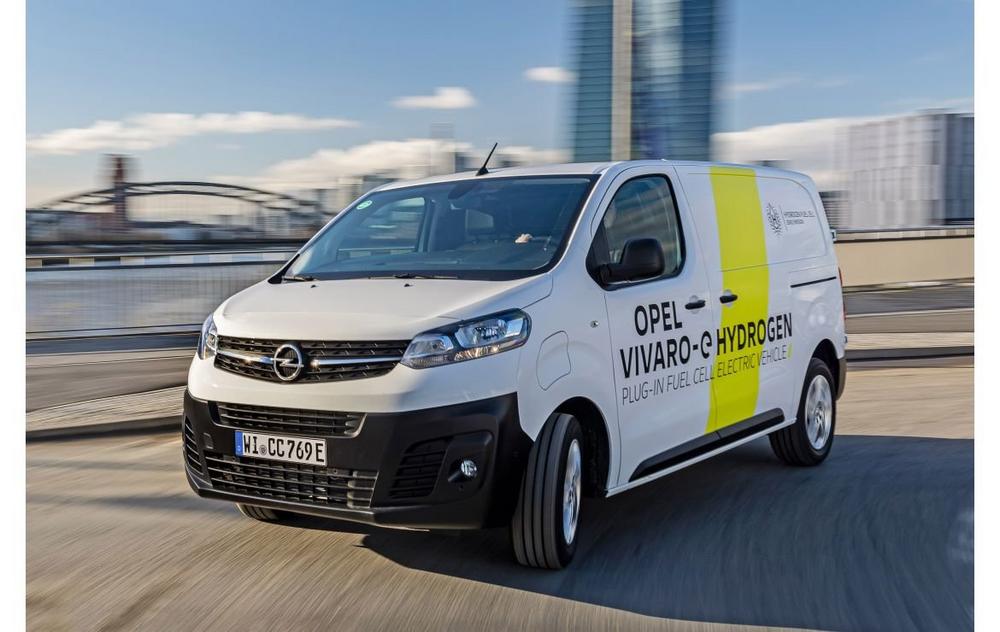- First customer: Miele will operate zero-emissions transporter
- For fleet use: Vivaro-e HYDROGEN fuel cell electric vehicle
- Time-saving: 3-minute refuelling for more than 400 km range (WLTP1)
- No compromises: Up to 6.1 m3 of cargo volume and 1,000 kg payload
- Pioneer: Stellantis first to put hydrogen LCVs onto the road
- Made in Germany: Series-production at Opel HQ in Rüsselsheim
The first hydrogen transporter from a vehicle manufacturer is ready to go. The first Opel Vivaro-e HYDROGEN off the production line will begin its emissions-free work in the fleet of the German manufacturer of premium domestic appliances, Miele. The hydrogen fuel cell vehicle from the brand with the Blitz will perform daily field service in the Rhine-Main region. Opel CEO Uwe Hochgeschurtz and Head of Development Marcus Lott were present at the start of production in Rüsselsheim.
“With the new Opel Vivaro-e HYDROGEN we are opening the next chapter in our sustainable mobility offensive. The clever concept combines the advantages of hydrogen fuel cell propulsion with the versatility and capabilities of our best-selling light commercial vehicle,” said Opel CEO Hochgeschurtz at Opel’s headquarters in Rüsselsheim.
Head of Development Marcus Lott added: “The new Vivaro-e HYDROGEN perfectly meets the requirements of fleet customers. The hydrogen van is the ideal solution for driving long distances with zero emissions as well as for transporting larger loads without losing time while charging the batteries. The Opel Vivaro-e HYDROGEN leads zero-emissions mobility into the future, especially for commercial use.”
Clever concept: Long driving range, zero emissions, quick refuelling
The Vivaro-e HYDROGEN is based on the existing battery electric Opel Vivaro-e, the “2021 International Van of the Year”. With full tanks of hydrogen, the driving range is more than 400 kilometres (WLTP1). The 45 kW fuel cell is capable of generating enough power for continuous highway driving. It takes only three minutes to refuel with hydrogen – about the same time needed to fill up a conventional diesel or petrol vehicle.
The 10.5 kWh lithium-ion battery provides dynamic peak power when required, for example, at start-up and under acceleration. Since the battery covers power needs in such situations, the fuel cell can run at optimum operating conditions. The battery also enables regenerative braking, while the plug-in capability offers the opportunity to recharge the battery externally if necessary, e.g. at a charging station, providing 50 km of pure battery electric range. The Vivaro-e HYDROGEN features a three-phase on-board charger (11 kW) and a mode 2 charging cable as standard.
Thanks to smart packaging, the Vivaro-e HYDROGEN demands no compromises on space compared to the combustion engine versions, offering up to 5.3 or 6.1 cubic metres of cargo volume. The fuel cell electric LCV is available in lengths M and L (4.95 and 5.30 metres) with up to 1,000 kilogrammes of payload.
Like its battery-electric sibling and those with internal combustion engines, the Vivaro-e HYDROGEN offers an unusually wide range of driver assistance systems that enhance safety. The equipment includes a 180-degree panorama rear view camera, blind-spot alert and front/rear park pilot.
The Multimedia Navi Pro infotainment system operates via voice recognition or colour touchscreen and is compatible with both Apple CarPlay and Android Auto. The navigation system offers maps for Europe, dynamic route guidance and TMC. Users can also cool or heat the vehicle during recharging via “OpelConnect” and programme charging times with the “myOpel” app.
The new Vivaro-e HYDROGEN benefits from more than 20 years of experience in the development of hydrogen fuel cell vehicles at Opel and Stellantis. Production takes place at Opel Special Vehicles (OSV) in Rüsselsheim. With the new Vivaro-e HYDROGEN, Opel is continuing its electrification offensive. Customers have the choice of selecting the drive concept in the Opel LCV portfolio that suits their application. The Vivaro-e HYDROGEN complements the Combo-e, Vivaro-e and Movano-e battery-electric vans that are already available to order.
[1] Range determined according to WLTP test procedure methodology (R (EC) No. 715/2007, R (EU) No. 2017/1151). The actual range can vary under everyday conditions and depends on various factors, in particular on personal driving style, route characteristics, outside temperature, use of heating and air conditioning and thermal preconditioning.
Opel Automobile GmbH
Bahnhofsplatz
65423 Rüsselsheim
Telefon: +49 (6142) 7-70
Telefax: +49 (6142) 77-8409
http://de-media.opel.com/de
Telefon: +49 (6142) 6921576
E-Mail: jan-philipp.kress@opel-vauxhall.com
Communications, Manager International Product
Telefon: +49 (6142) 69-22084
E-Mail: colin.yong@stellantis.com
![]()

